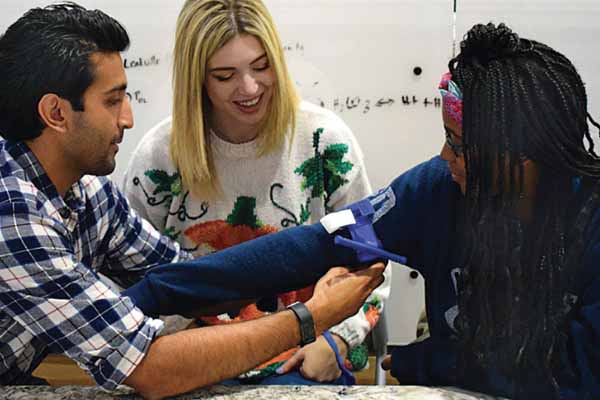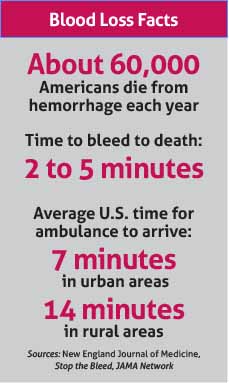
For Austin emergency physician Jason Pickett, MD, promoting greater public awareness about emergency hemorrhage control often starts with debunking myths about the tourniquet.
Misinformation about tourniquets goes back decades and is widespread, he says. Many people still see them as a last-ditch measure that too easily causes infection or amputation by choking off a limb’s blood supply.
“‘Tourniquets are harmful – you’re making a decision of life over limb. They’re going to lose their arm,’” Dr. Pickett said, citing one myth. “And our experience in wartime and on the civilian side has not borne that out at all.”
In fact, tourniquets are extremely safe when used even by people with minimal training, says Dr. Pickett, deputy medical director of Austin Travis County Emergency Medical Services (EMS). And because uncontrolled bleeding is the No. 1 cause of preventable death among trauma patients, tourniquets are a vital piece of emergency equipment, he says.
“That’s one of the big things that we’ve been working to get out of public consciousness, even among medical providers, even among physicians and paramedics and EMTs, who believe that they’re harmful when they really aren’t,” he said.
The need for improved training on hemorrhage control in emergencies has been building for decades. It started with physicians in the U.S. military, who have been refining lessons about wound care during almost 20 years of constant combat operations overseas, Dr. Pickett says.
Civilian physicians took up the cause of hemorrhage control after the 2012 mass shooting at Sandy Hook Elementary in Newtown, Connecticut. That prompted the American College of Surgeons to bring together subject matter experts to write the “Hartford Consensus,” a series of recommendations for surviving mass casualty events. In 2015, this prompted the Obama administration to create
“Stop the Bleed,” a national public awareness program (www.dhs.gov/stopthebleed).
Stop the Bleed encourages bystanders to get trained and equipped to help during a bleeding emergency. In 2017, Georgia became the first state to require hemorrhage control kits as well as training for students in all public schools.
In 2019, Texas followed suit. The legislature passed House Bill 496, which required “bleeding control stations” in all public and charter schools. Those stations must contain hemorrhage-control supplies, including a tourniquet, chest seals, compression bandages, latex-free gloves, and an instruction manual. Schools also must provide annual training on how to use that equipment to students in seventh grade and higher.
Physicians should join these public school efforts, says Andrew D. Fisher, MD, who graduated in May from Texas A&M University College of Medicine in Temple and will start his general surgery residency in Albuquerque, New Mexico, this summer. For instance, they can serve on school health advisory councils (tma.tips/TexasSHACs).
But Dr. Fisher, a former physician assistant who served with the U.S. Army’s 75th Ranger Regiment in Afghanistan and Iraq, says it’s just as important to reach out to the community to promote hemorrhage control in the same way CPR and other life-saving methods are promoted.
“You can create laws all day, but I think that only goes so far,” he said. “Really, I think most of the improvements [in awareness about hemorrhage control] happen at the local level.”
 Zero deaths
Zero deaths
Recent medical studies show how military success with tourniquets can be adopted in civilian use (tma.tips/TexasTourniquet). Dr. Fisher says his old military unit can serve as exhibit A in why hemorrhage control education works in treating survivable injuries – medical emergencies that people can live through if treated quickly.
While other U.S. military units had a 24% mortality rate in the early 2000s for potentially survivable injuries – like a wound to an arm or leg – the 75th Ranger Regiment had zero such deaths in this same period, he says.
That is because the unit became an early adopter of Tactical Combat Casualty Care (TCCC) (tma.tips/TacticalCombatCare). This protocol stresses identifying and treating the three leading causes of survivable death: massive hemorrhage from an extremity, tension pneumothorax, and airway obstruction .
For severe extremity wounds, it calls for early tourniquet application.
“As we went to the wars in Iraq and Afghanistan, everyone [in the 75th Ranger Regiment] knew how to do that,” he said. “[We recognized] how if we treat everyone as being responsible for the person next to them and being able to identify and treat the three major causes of survivable deaths, then they take ownership, and we see the result.”
That inspired TCCC’s civilian counterpart, Tactical Emergency Casualty Care (tma.tips/TacticalEmergencyCare), which is used to train emergency personnel. The impact on police has been especially pronounced, Dr. Pickett says.
“It feels like time and time again, I’m writing a life-saving award for Austin police who manage to stop hemorrhage successfully on somebody in the field well before EMS arrived,” he said. “And that’s exactly what needs to happen. If you wait for the medics to arrive, for a lot of folks that’s way too late.”
The main goal of Stop the Bleed is to turn ordinary people into emergency responders. But there are big hurdles to overcome, Dr. Pickett says. Many people untrained in medicine are understandably reluctant to act quickly for fear of doing more harm. But because an injury victim can bleed to death in within five minutes, the first step is to teach people not to hesitate, he says.
Even when people do act, they often act using dangerous misinformation. For instance, those who are biased against tourniquets often use less-effective bleeding control measures.
“Pressure points and elevation really aren’t as effective as a tourniquet at stopping the bleeding,” he said
Also, a surprising number of people mistakenly try to use tampons as a way to speed up the clotting process with serious wounds, he says.
Community action
Stop the Bleed teaches people mainly to use tourniquets and methods that apply direct pressure as the surest ways to stop bleeding.
The program now has 9,550 instructors in Texas who have trained 60,769 people, according to the American College of Surgeons. Many of these programs have been set up either by or with the help of regional advisory committees (RACs), Dr. Fisher says (tma.tips/TexasRACs).
In 2018, Stop the Bleed helped inspire then-first-year medical student Abraham Akbar at the Baylor College of Medicine in Houston to start Lone Star Survival, a group of about 200 medical students at 12 Texas medical schools who teach bleeding control methods mostly at large venues like football games, gun shows, and student unions.
While Stop the Bleed offers full hour-plus courses on hemorrhage control, Mr. Akbar founded Lone Star Survival to give 10- to 15-minute tutorials on the basics – especially tourniquet use and compression.
Funded by the Texas College of Emergency Physicians, Lone Star Survival conducted a scientific study that found these tutorials make people more likely to render aid and give them the skills to do so. For instance, it found that trainees’ knowledge of correct tourniquet placement rose by about 43%.
Mr. Akbar, who worked as an advanced emergency medical technician before entering medical school, says many beginning medical students don’t have training in hemorrhage control.
“Obviously in medical school you learn a lot more about the diagnostics and the clinical medicine,” he said. “But I kind of had the feeling that a lot of medical students even in our first and second years wouldn’t necessarily know how to stop the bleeding for someone who is in that kind of situation.”
Lone Star Survival is in the process of expanding to California. But as of early May, most Stop the Bleed and Lone Star Survival activities have been put on hold as people practice social distancing to avoid contracting COVID-19.
In the meantime, the medical community should stay up to date on emergency hemorrhage control, Dr. Fisher says. That begins with regular instruction in all medical schools. For instance, Texas A&M University College of Medicine students must be certified in CPR before their first day of class.
“Let’s teach CPR in conjunction with hemorrhage control during orientation at medical school,” he said. “So when students come out of the first week of medical school, they have two different skill sets that can be applied in the community.”
Under the supervision of a physician, Longhorn Stop the Bleed at The University of Texas at Austin has since trained 4,000 people in Central Texas. Also, the university has placed at least one trauma kit in every building on the UT-Austin campus, and more in buildings that get heavy traffic, says Claire Zagorski. She is a paramedic who founded Longhorn Stop the Bleed in 2017 after an attacker stabbed four students at the university – one fatally.
While hemorrhage control kits now appear more frequently in public places, alongside defibrillators and fire extinguishers, they still lag far behind those other emergency tools, Dr. Pickett says.
“Medical providers are starting to understand the benefits of … putting it in the hands of the average citizen, who is in the airport or in the shopping mall [when] something bad happens, to make sure that they have those tools available,” he said.
Tex Med. 2020;116(7):42-45
July 2020 Texas Medicine Contents
Texas Medicine Main Page